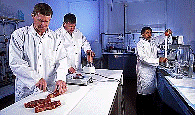United States Department of Agriculture: Agricultural Research Service, Lincoln, Nebraska

Roman L. Hruska U.S. Meat Animal Research Center: Reports
Date of this Version
2007
Document Type
Article
Citation
Published in Meat Science 77 (2007) 90–96. DOI:10.1016/j.meatsci.2007.04.004
Abstract
The Escherichia coli O157:H7 (E. coli O157:H7) outbreak in the Northwestern United States ushered in an era that has dramatically changed the way beef processors in the United States convert live cattle into meat. Unprecedented cooperation among the beef processors and massive investment in research by the US government and the beef industry have resulted in an acceptable level of control of E. coli O157:H7 in ground beef. The evidence to support the progress in control of E. coli O157:H7 is the CDC data for reduction in human illness as well as the dramatic reduction in the number of E. coli O157:H7-positive samples in USDA-FSIS ground beef monitoring. This manuscript highlights some of the recent findings from our laboratory on the control of E. coli O157:H7 in ground beef. We have also summarized the key events/decisions/milestones that have contributed to the control of E. coli O157:H7 in ground beef in the United States. While there is much to be done to bring E. coli O157:H7 under complete control in the beef sector of the food industry, E. coli O157:H7 also is becoming a major issue in the fresh vegetable sector, as evidenced by the 2006 outbreaks in the United States. We have discussed how the fresh vegetable industry can benefit from the beef industry’s experience to expedite the control of E. coli O157:H7 in their products.

